The clash between RB Salzburg and LASK Linz was one of the best matches of the Austrian Bundesliga this season as Salzburg sat in the first position with 44 points after the opening 18 games while Linz were just two points behind them. After the winter break, the Austrian top-flight returned with this incredible game.
The team of the American coach, Jesse Marsch, have not lost a single match this season, winning 13 and drawing five times. Also, the first clash between these two top teams in this season ended with a 2:2 draw, so it was clear that this would be a thrilling match on a high level.
In this tactical analysis, we’ll look at both teams’ tactics and explain how LASK Linz were able to lead with 1:2 at half-time away from home, and remain in front after the 90 minutes, as the final scoreline was 2:3
Lineups
Since in both squads, almost no important players were injured, both managers could line up their best 11 players for this game. Marsch went once more with a 3-4-1-2 formation with Cican Stankovic in goal, and the back three was made of Maximilian Wöber, Jérôme Onguéné and André Ramalho while the wing-backs were Andreas Ulmer and Patrik Farkas. Enock Mwepu, Zlatko Junuzović and Masaya Okugawa occupied the central midfield while upfront Hee-chan Hwang and Patson Daka had the task to score the necessary goals. After Erling Haaland’s move to Borussia Dortmund, the people had a special eye on them.
On the other side, Valérien Ismaël used the usual 3-4-3 formation with Alexander Schlager between the sticks and the back three, which consisted of Gernot Trauner, Philipp Wiesinger and Petar Filipovic. James Holland and Peter Michorl were the only two central defenders, while Reinhold Ranftl and René Renner were the wing-backs. The three men upfront were Dominik Frieser, Marko Raguž and Thomas Goiginger.
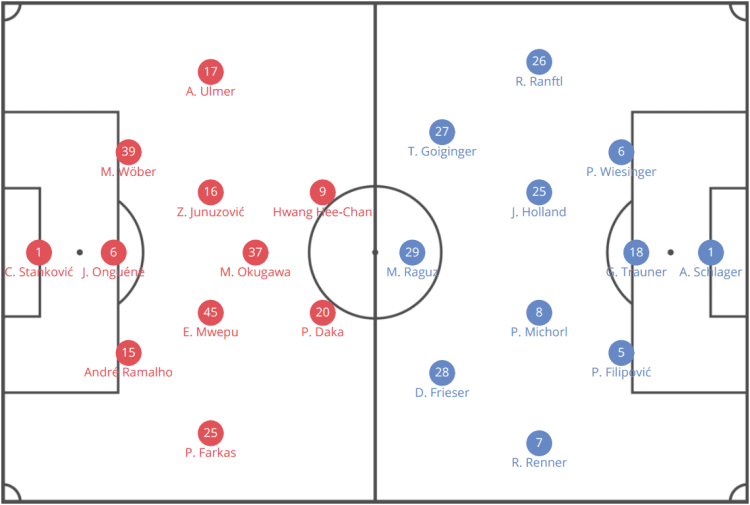
The wings as key-areas
So, when we look at the formations of both teams, we see that both played with a back three what is quite rare nowadays. Furthermore, we can see that RB Salzburg clearly had more men in the middle of the pitch as they have three central midfielders while LASK Linz just had the two with Michorl and Holland. Additionally, Marsch’s team had two more central orientated strikers (on the teamsheet) while Linz had, with Raguž, just one (white zone in the image).
However, as we can see in the image below, Ismaël’s squad had on both wings two players while the home side just had Ulmer and Farkas, respectively (black zones in the image). These wide-areas were in this match quite important as we’ll see in this opening part of this tactical analysis.
Also, I marked in the image below the spaces on the wing on the height of the back three of Linz as this area was, especially in the opening phase of this match, important since Salzburg permanently tried to get into this space to create a goalscoring chance from there (orange zone).
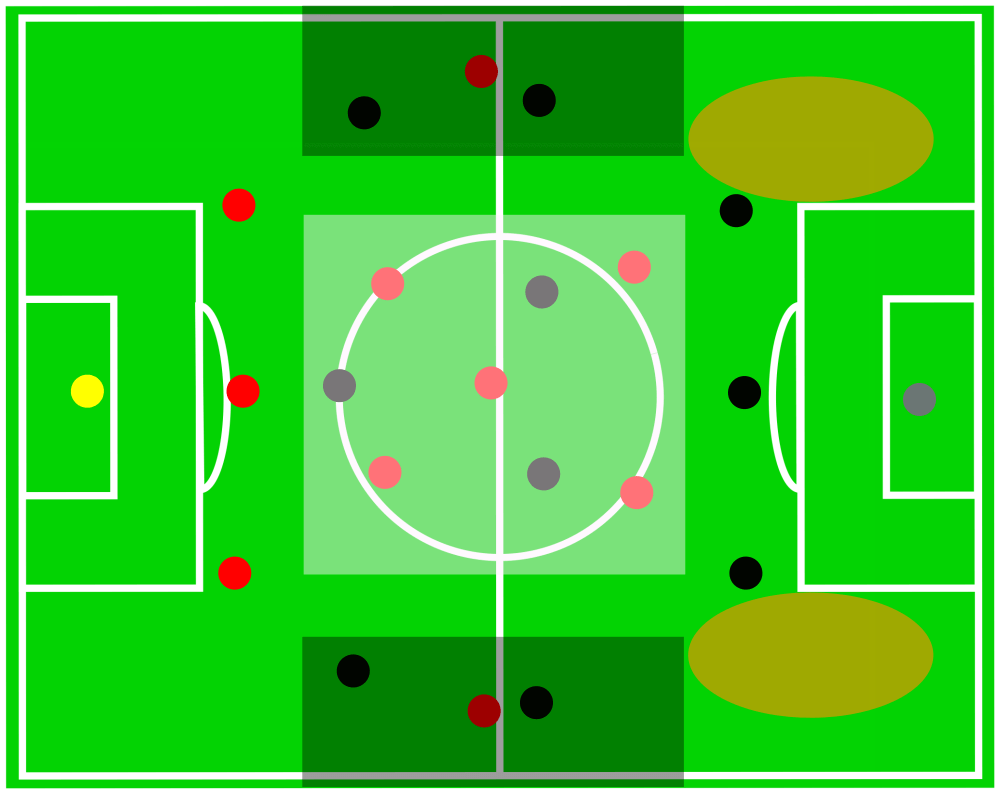
Marsch wanted to get with his team into these areas since then they could force the back three of Linz into sprint duels with Hwang, Daka, Okugawa, Ulmer or Farkas as every one of them would beat them in a race. So, Okugawa, Hwang and Daka didn’t always stay in the centre but drifted to the outside to receive through passes. Also, the fact that the two outer centre-backs of LASK Linz, Filipovic and Wiesinger, were in this game just in two and three respectively aerial duels involved shows, that Salzburg wanted to play long balls in the space behind and next to them and not in an area where they would get involved in an aerial duel, but we’ll look at Salzburg’s long balls later in this analysis.
Notice in the two images below how Hwang beats his opponent Wiesinger to the ball while Daka is meanwhile already sprinting into the box to then receive a low cross, but he misses the chance to score.
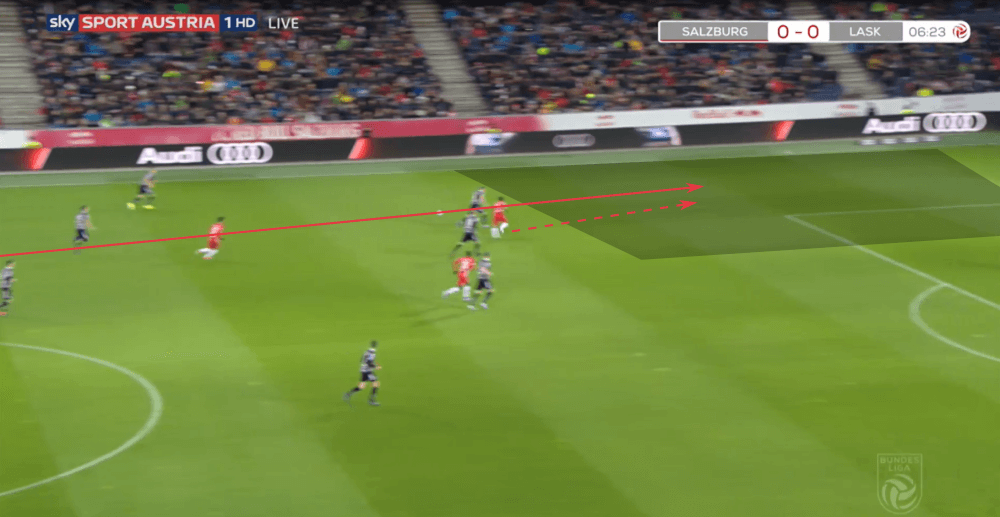
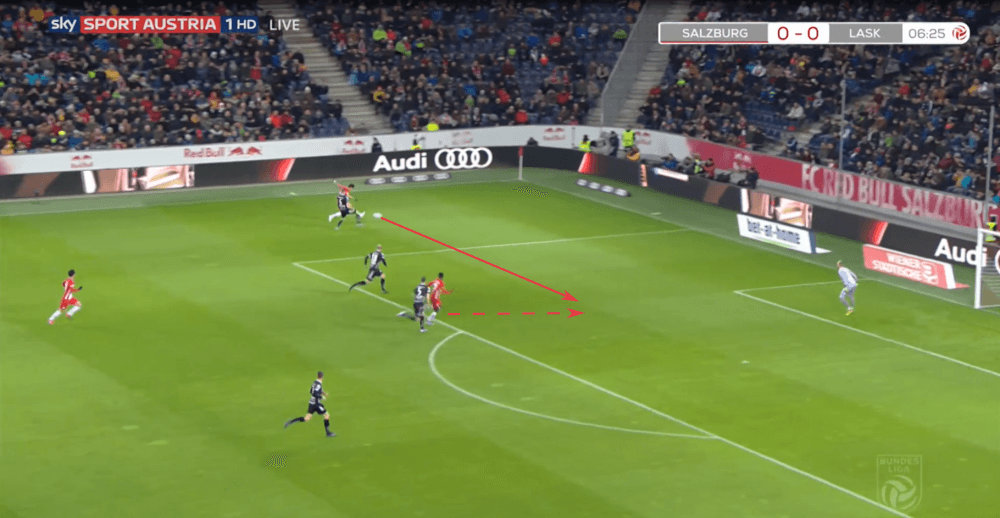
Marsch’s team used these long through balls during the build-up and also in the moments of offensive transition, but at this point, I also need to add that it was noticeable that they mainly attacked down the left-wing and rarely down the other side. The two reasons for that are that firstly Hwang was the left forward and is faster compared to Daka and also likes to position wider while Daka is a forward who stays more centrally. Additionally, Ulmer’s role was slightly more offensive compared to the one of the right wing-back Farkas.
The away team had a hard time in the opening phase of this match as Salzburg permanently used long through balls to the left-wing behind the back three of LASK and delivered from there low crosses into the centre. Marsch’s team shot during the opening 15 minutes of this clash four times and hit two times the post. Meanwhile, Linz did not have a single shot and were in huge trouble as it seemed as it would be just a matter of time until they would concede a goal.
On the other side, it was clear that LASK Linz would also especially try to break through over the wings since there they had numerical superiority as already described. In the opening phase of the game, Linz wanted to attack down their left-wing since this side was Salzburg’s weaker one with Farkas and Ramalho compared to the other wing with Ulmer and Wöber. Also, you have to mention that the right wing-back Farkas played his first game in the Austrian Bundesliga since October 2019 since he needed to take a break after a stroke.
So, we would have on the left-wing of LASK a two-on-two situation with Renner and Frieser against Farkas and Ramalho. However, the central midfielder Mwepu often shifted to the outside as soon as the ball was played wide to create numerical superiority, as it can be seen in the image below. In this situation, the left-winger Frieser went into the centre while the centre-forward Raguž positioned more on the left side, but still, we can see that Mwepu comes to the wide-area to support his teammates.
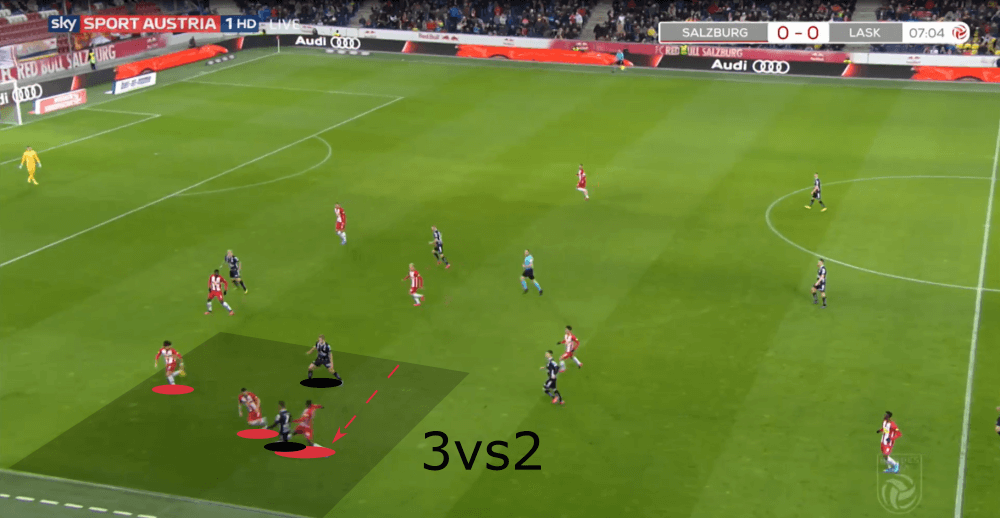
During LASK Linz’s offensive transition, they often tried to exploit the same space as Salzburg: behind the outer centre-backs of the back three. During the counter-attacks, they immediately tried to play the ball wide to find Ranftl, Renner, Goiginger or Frieser with a through pass and exploit their pace as it can be seen below. In this example, Renner receives a through pass and already picked up speed. Due to that, he would easily beat Ramalho to the ball, who has to foul the opponent to avoid a goalscoring chance.
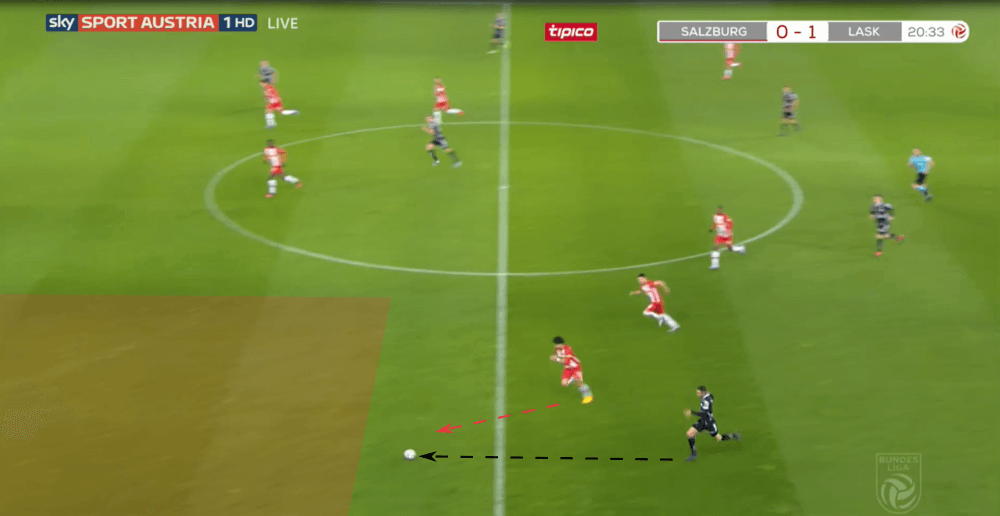
Linz’s man-orientated approach
As already mentioned, Salzburg were in the opening 15 minutes really dangerous and had four shots. Also, in this short period, their xG value was already 0.53, while the opposition had zero. Considering this, LASK were lucky that Salzburg’s conversion of goalscoring chances was quite bad in this early stage of the game since it would have been no surprise if they had already scored one or two goals. However, Ismaël and his team got rewarded for their extremely brave style of play out of possession at which we’ll look now.
This season, Salzburg have by far the best offence of the Austrian Bundesliga as they score on average 3.36 goals per game while the second-best team Wolfsberger AC have a value of 2.19. But LASK played without any fear and used in most periods of the game a man-orientated defensive style of play as every player had exactly one opponent to mark. Since you never see all 22 players at once in the TV footage, I illustrated it in the image below. The back three marked Salzburg’s two strikers and the high positioned Okugawa while Michorl and Holland looked after their direct opponents in the centre. The wing-backs man-marked their opponents on the wing while the front three looked after Salzburg’s back three.
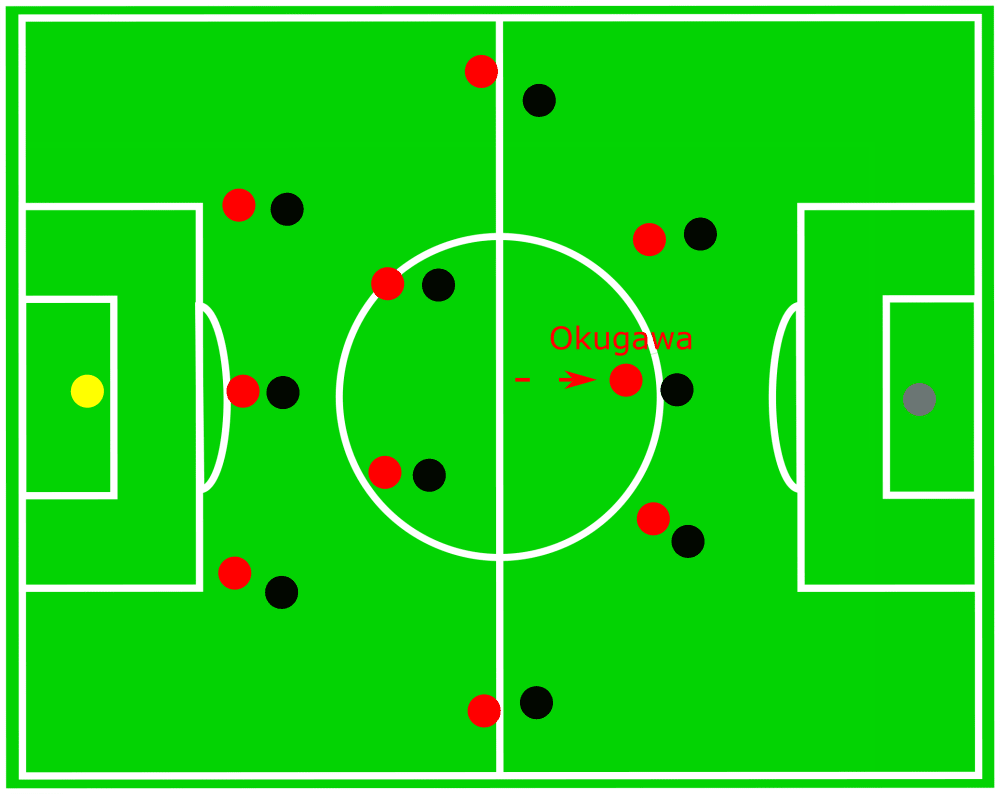
Besides, especially during the opening minutes of the game, Ismaël’s team put pressure on the home side extremely high up the pitch and didn’t give them any time to have calm and structured build-up. These tactics caused the back three of LASK Linz huge problems in the first 15 to 25 minutes of this clash as they often found themselves in sprint races against the fast offensive players of Salzburg as already described earlier in this tactical analysis.
Anyways, we also saw often that Marsch’s squad had huge problems in playing out from the back as LASK pressed in at them already at the height of their often penalty box. When the goalkeeper Stankovic was on the ball, Raguž, Frieser and Goiginger were near the back three, but not marked them to provoke the short pass and then immediately put pressure on the back three while the central midfielders Mwepu and Junuzović were marked tightly by Michorl and Holland.
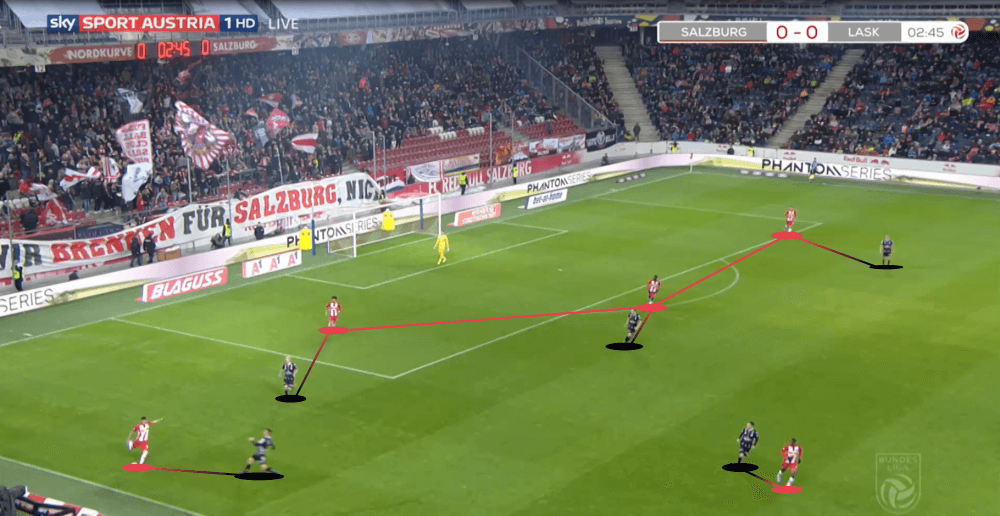
Since the central passing options were cut off, Salzburg either played such long balls behind LASK’s back three as we already have seen or another type of long balls at which we’ll look later in this tactical analysis. The third option was the pass to one of the wing-backs who positioned wide to stretch the opposition. However, this pass to Farkas or Ulmer, who were positioned near the touchline, was exactly what Linz wanted as then they cut off all passing options and at the same time, LASK’s wing-backs put pressure on them in a one-on-one situation. In these situations, we once more saw the man-orientated and brave approach of Ismaël and his team.
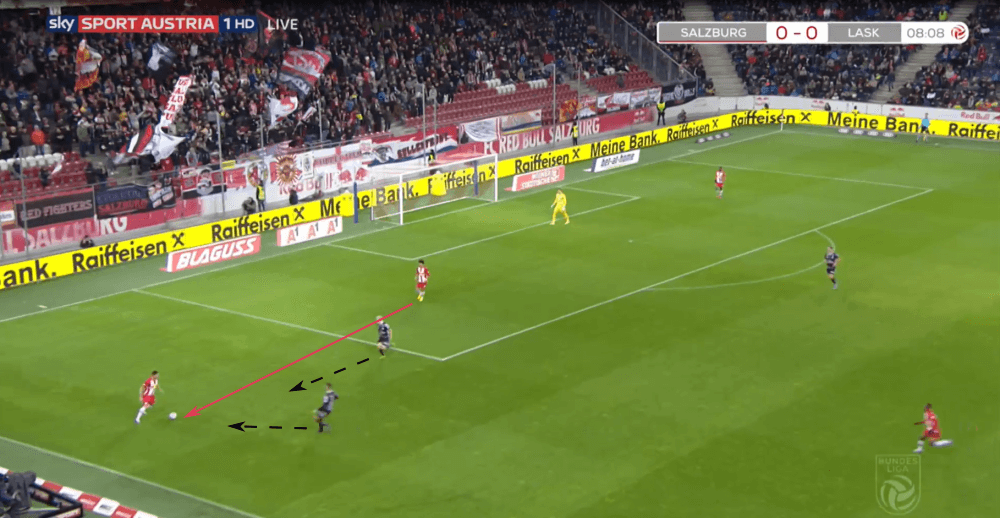
Due to this aggressive press, which LASK didn’t only execute in the opening phase, but in this time, the most intense, Salzburg had huge problems in building up their attacks with short passes. When we look at their long pass share below, we can see that in the first 15 minutes of each half, Salzburg had the highest values (37% and 36%) since these were the periods in which LASK’s man-orientated approach worked off the best.
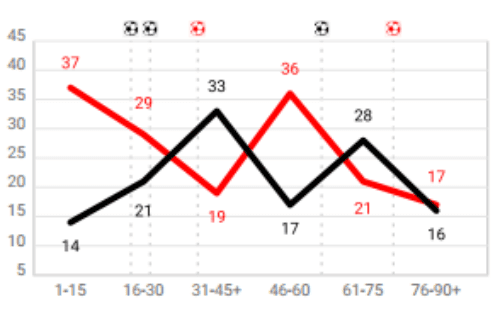
Shortly after half-time, Junuzović showed an interesting movement which could help Salzburg to overcome this man-orientated pressing. The Austrian central midfielder dropped deeper on the left side while the ball was played to the left centre-back Wöber. This lured Ranftl out of his position as Junuzović’s usual marker didn’t follow him. Because of that, Ulmer was for one moment unmarked, and Wöber tried to find him with a pass, which was unfortunately not precise enough as we can see below. Anyways, these movements would have helped Salzburg massively, but they used them not often.
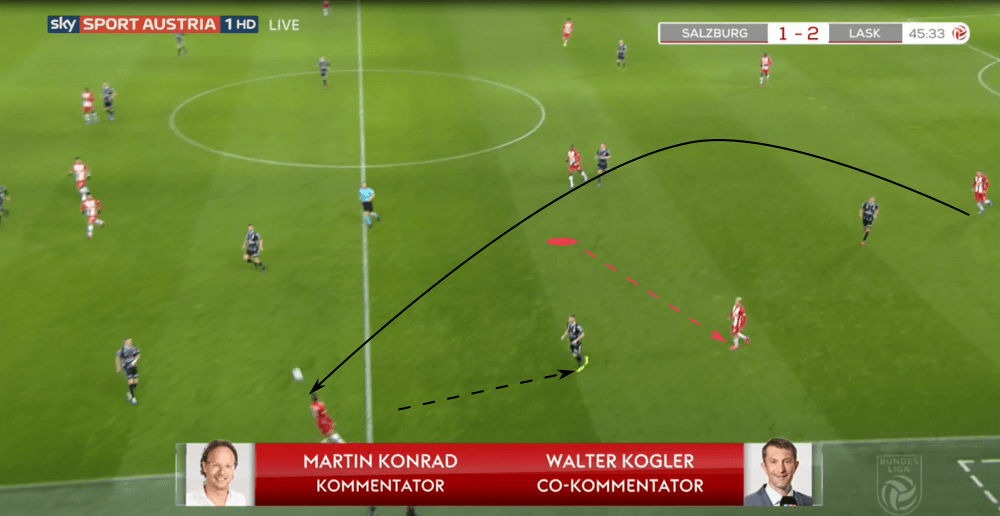
On the other side, it was clear that LASK wouldn’t be able to execute such a high and intense pressing over the 90 minutes. In the light of this, they dropped in some periods of the game back deeper and used a midfield pressing in a 5-2-3 formation. Even though in these situations, the back five and the two midfielders didn’t continue to use the man-orientated approach, the three forwards did. When they dropped deeper and just put pressure on the back three of Salzburg at about the half-way line, the front three continued to play man against man, as we can see in the example below. This made it hard for RB Salzburg to circulate the ball during the firsts stage of the attack and caused them some problems.
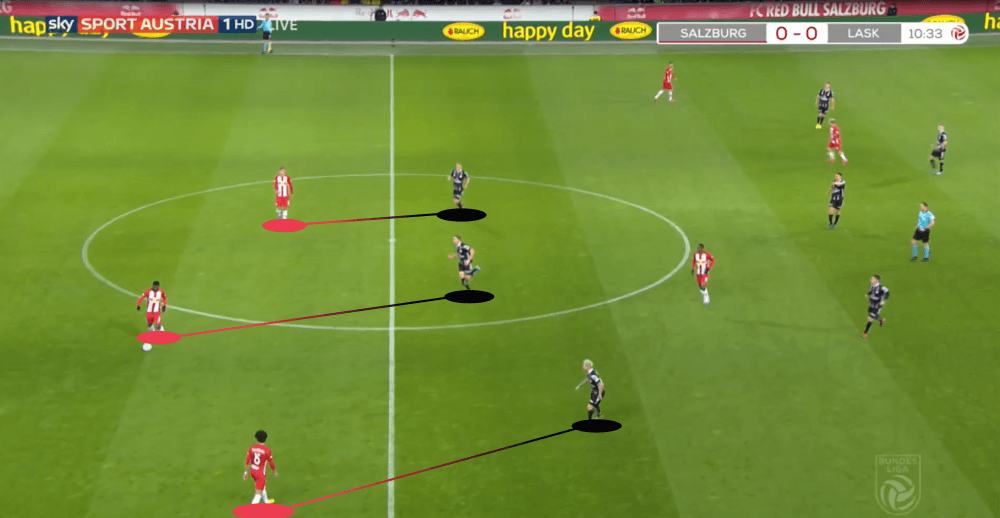
(Counter-)pressing on both sides
Ahead of this match, Salzburg had in the Austrian Bundesliga on average a PPDA (passes per defensive action) value of 5.4 while Linz’s one was 6.55. Both teams are in this category among the best three teams of the league, as Marsch’s team have the lowest and LASK the third lowest. Due to that, it was clear that we would see a match in which both squads use an aggressive pressing and counter-pressing, and you also have to add that both teams are known for that.
In this game, Salzburg had a value of 6.2 and Linz 7.4 which both are higher than their average but still show that both teams didn’t want to give the opposition the control over the game. We already looked at LASK Linz’s man-orientated pressing in this tactical analysis, but they also used a counter-pressing which often worked off as we can see for example ahead of their second goal as they won back the ball on the left-wing and just seconds later Holland scored with a deflected shot from distance the 0:2 for the away team.
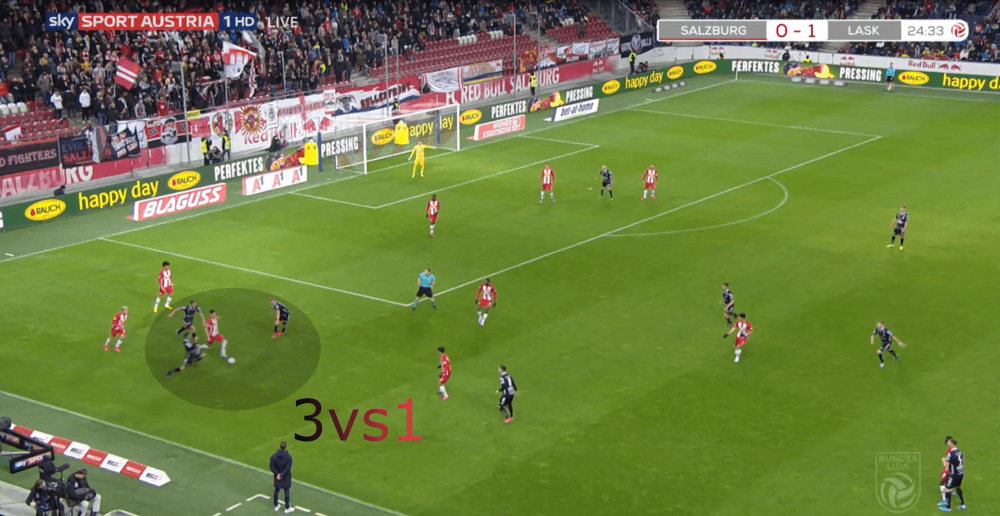
Anyway, as the values tell, RB Salzburg also tried to use an aggressive counter-pressing to give their opponents not even the chance to start counter-attacks over the flanks. So, as soon as one of Salzburg’s players lost the ball, he and the teammates who were positioned nearby, immediately put pressure on the opponent as we can see in the shot below as three players of Marsch’s team press in at Wiesinger who has no other option than to play the ball back to his goalkeeper.
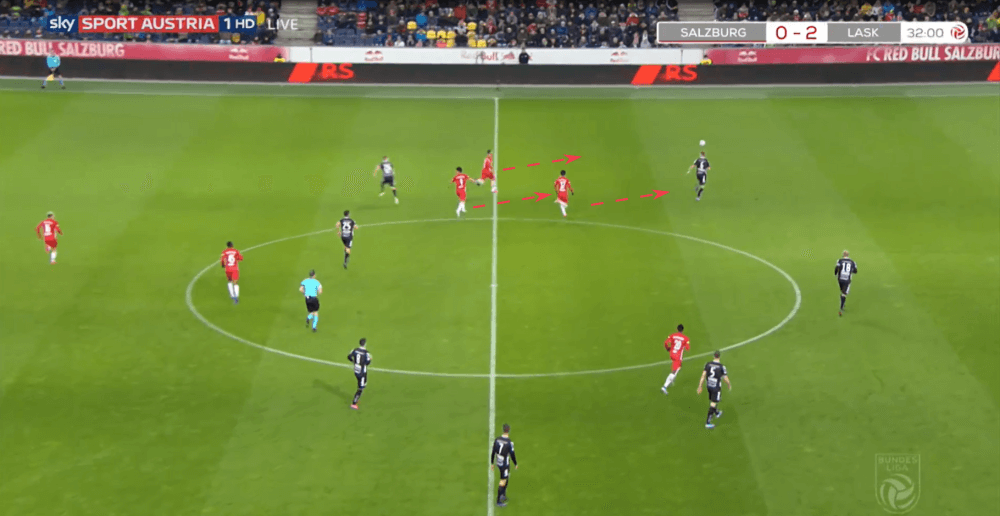
The home side forced their opponents with their high pressing and the counter-pressing often to long balls, as we’ll see in the next paragraph. However, the really astonishing aspect of the pressing of both teams was the intensity and how they executed it, almost until the final whistle of the match. Of course, both teams sat back deeper in some periods of the game, but in general, they used the pressing for the majority of the 90 minutes. For example, LASK’s players even executed the counter-pressing in the last 15 minutes of the match even though they were with 1:3 in front, as we can see below.
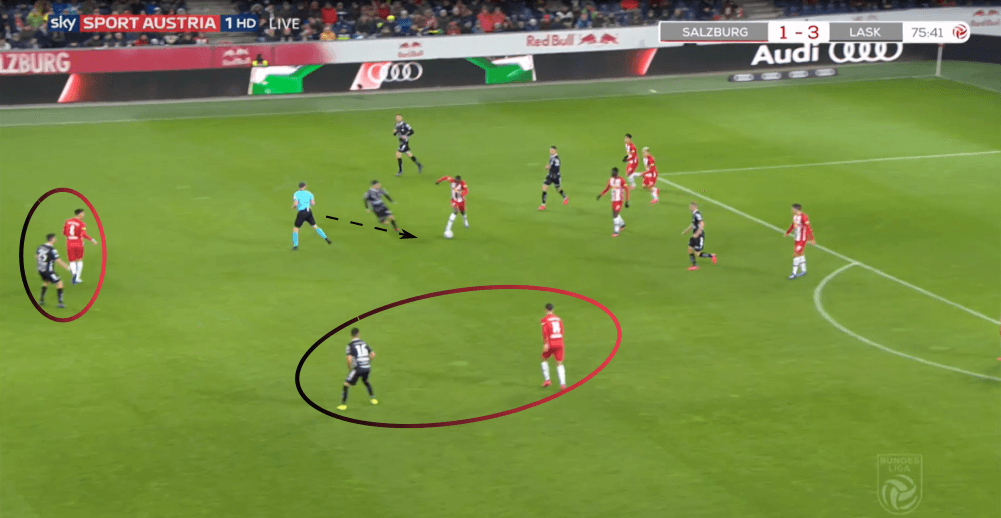
Raguž’s underlying importance
RB Salzburg is famous for their high, aggressive and intense pressing and also big clubs like Liverpool or Napoli had their problems with it in the UEFA Champions League in this season’s group stage. Also, in this game, LASK had problems with it as they weren’t able to have a structured build-up since RB Salzburg didn’t let them at all. As usual, Marsch’s team used a bit similar pressing tactics as Linz as they forced them to play to the wide-area and then cut off all short passing options, as we can see below. However, the huge difference was, that LASK had with Raguž one man upfront who had the task to receive long passes and lay them off when Salzburg pressed in at his team.
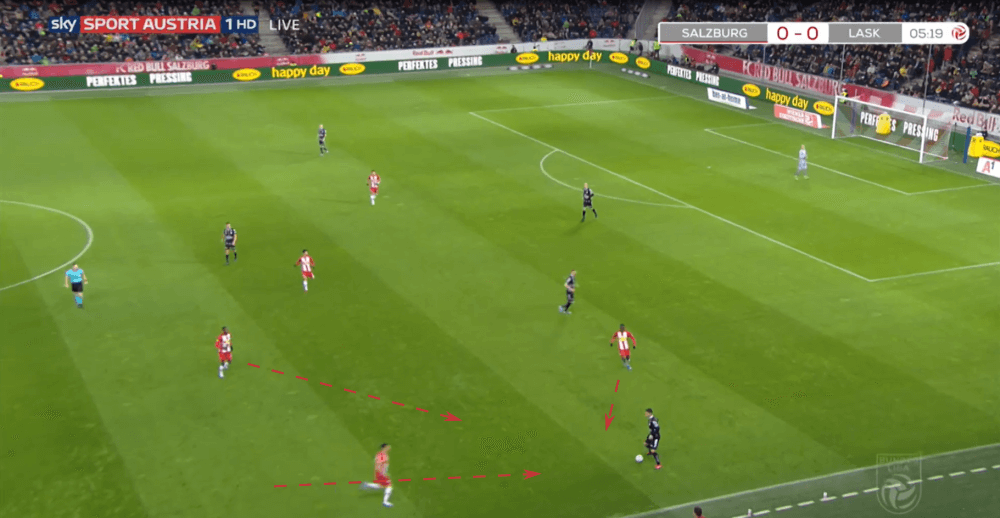
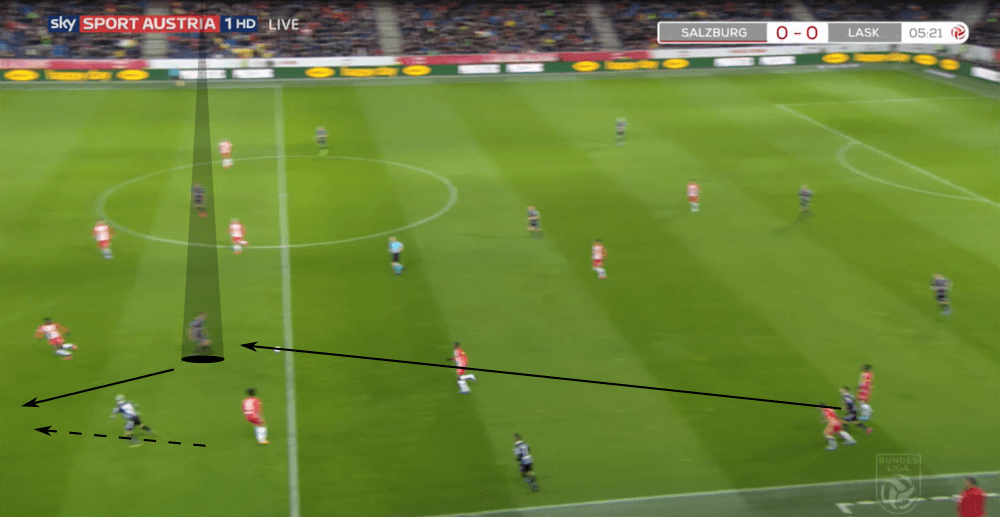
The Austrian forward was in this game in 19 aerial duels involved and was the main target for the long balls for LASK Linz whenever Salzburg put pressure on them so high up the pitch, that they had no chance to have an organized build-up with short passes. Besides, when we look at his heatmap for this game below, it’s obvious that he positioned himself quite often in the left half-space. The first reason for that is that the majority of Linz’s attacks went down this wing as they thought that they would break through more easily on this side. The second aspect is that Raguž mostly positioned in this space whenever the goalkeeper Schlager was about to play long ball.
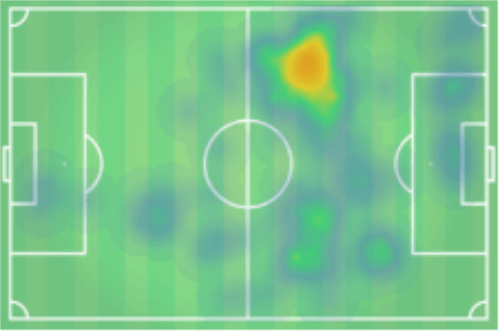
At this point, I have to add that Linz didn’t just play long balls when they had no short passing options due to Salzburg’s good pressing, but also Schlager often didn’t even play the short pass as he knew that the home team just waited for that to then instantly execute their pressing. Ahead of these long balls by the goalkeeper, The two wingers Frieser and Goiginger positioned near Raguž who was always the player who should receive the long balls while the other two forwards tried to win the second ball together with the central midfielders Michorl and Holland. We can see in the image below their typical positioning ahead of the long ball as they stand close to each other and exactly in the space which is also highlighted in the heatmap of the central striker.
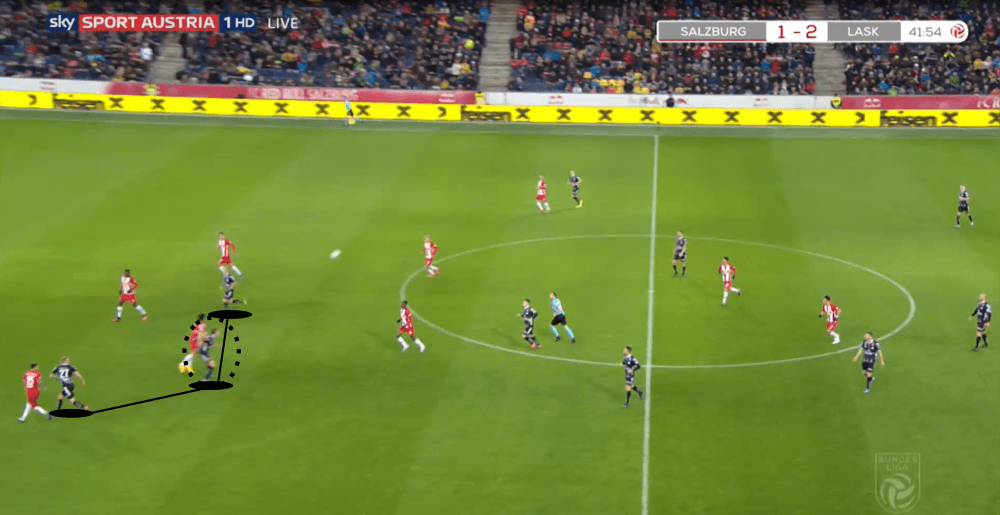
Anyways, the 21-years-old forward also provided one assist and ahead of that, he once more made use of his physical strength as permanently did in this match when his teammates tried to find him with long balls. We will look at the throw-in tactics of LASK Linz later more detailed in this tactical analysis, but in this case, it was just Raguž’s pure will combined with his physical strength and technique as he stayed on the ball against three defenders after a throw-in to then deliver a perfect low cross into the centre where Frieser just had to tap it in to score the 1:3.
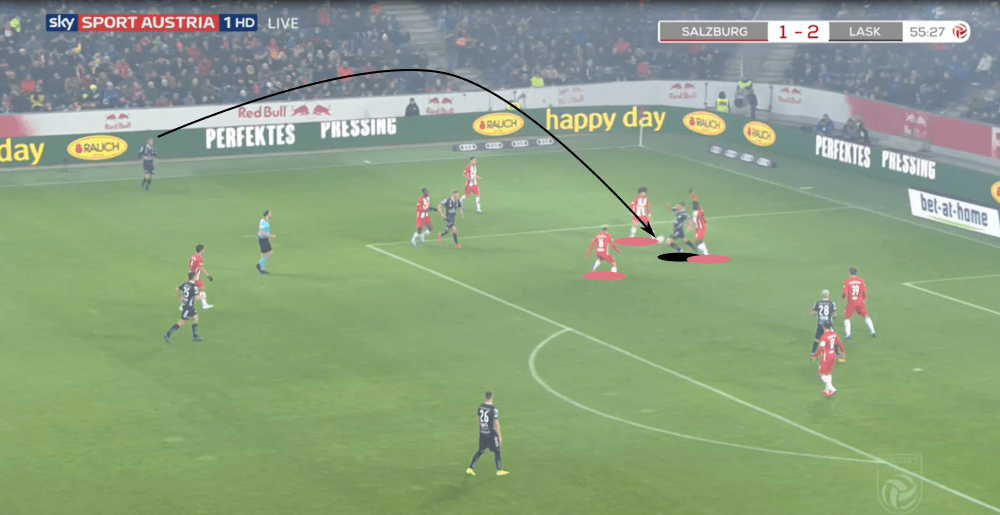
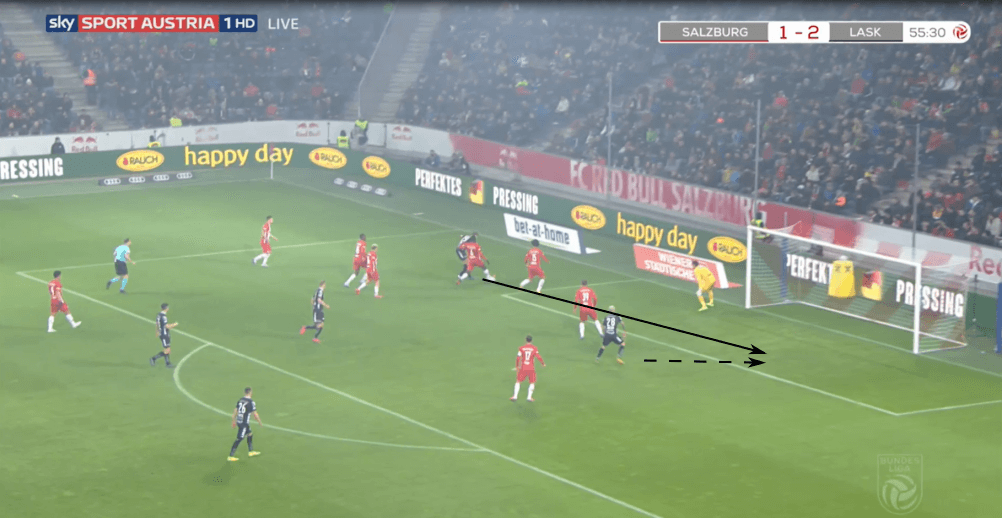
Salzburg’s typical long balls
As already described, Salzburg used especially in the opening phase of this match long balls on the wing behind the back three to force the centre-backs of Linz to go into a race against the quick offensive players of the home side. However, since the short passing options were mostly cut off and additionally LASK’s back three positioned slightly deeper and wider to avoid these long balls behind them, Salzburg had to play long passes towards the two strikers who had to go into aerial duels.
As already mentioned, the two outer centre-backs of the back three Filipovic (two) and Wiesinger (three) weren’t involved in that many aerial duels. However, the central man of the defence, Trauner, was involved in 15 aerial duels as Salzburg played so much long balls and he also won 11 of them what is no surprise as he has with a success rate of (76.24%) the second-highest value in the Austrian Bundesliga and Salzburg’s forwards are not extremely strong in aerial duels.
However, such long balls are typical for RB Salzburg, and it was no surprise to see them once more in this match as they played in this clash 105 long balls in the 90 minutes. Anyways, the main goals of these long balls are to either win the second ball or immediately start the counter-pressing in the high area of the pitch. Especially in games like these when the opponents use a high pressing and Salzburg rarely find a way to progress the ball with short passes, they like to use such long balls to get into the higher areas of the pitch.
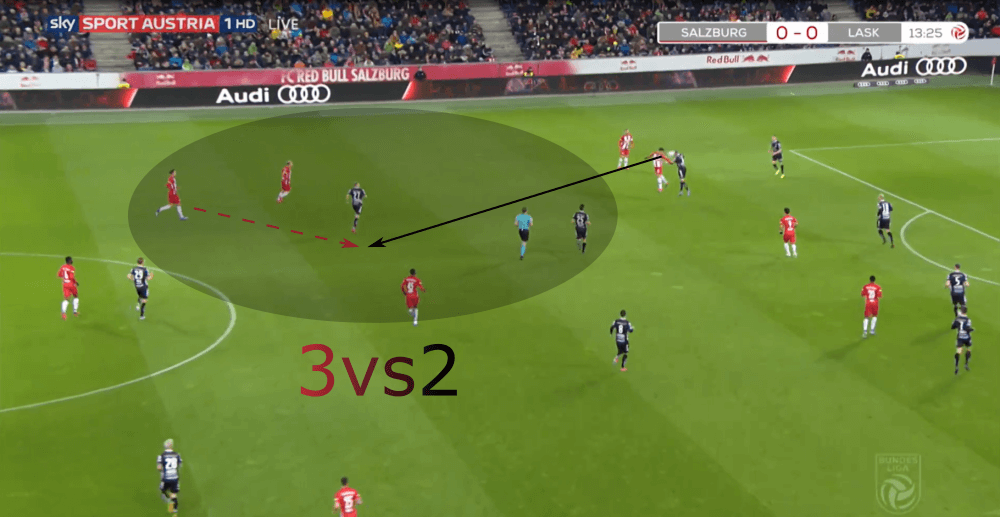
In the example above, the right striker Hwang loses the aerial duel against Wiesinger after a long ball, but it doesn’t really matter as Salzburg have enough players near the area where the ball comes down, and Wöber wins the second ball.
However, the offensive players of Salzburg sometimes also were able to lay off these long passes to the players who pushed forward from the deeper positions and then they were in a great position to continue the attack. We can see a perfect example of that below as Daka lays off the ball for Hwang, who can then immediately pick up speed with the ball at his feet while he has three teammates with him.
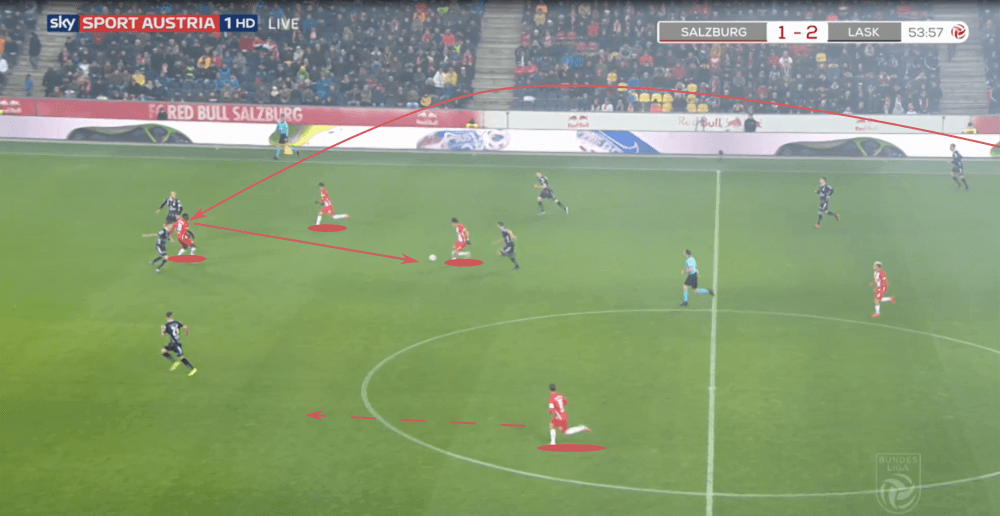
Adjustments in the second half
LASK Linz scored the already mentioned 1:3 in the 56th minute of this duel, but Salzburg was in the following minutes just not able to get the control of the game and rarely had goalscoring opportunities. Due to that, Marsch wanted to change something and brought between the 58th and 64th-minute Mergim Berisha for Farkas. At the same time, the talented Dominik Szoboszlai replaced Ramalho what led to a systematic change. Ismaël also made three changes, but the system, as well as the tactics, stayed the same, and due to that, we’ll only shortly look at RB Salzburg’s adjustments, which led to almost nothing. In the image below, we can see Salzburg’s new system after the 64th minute as they switched to a 4-1-3-2 formation.
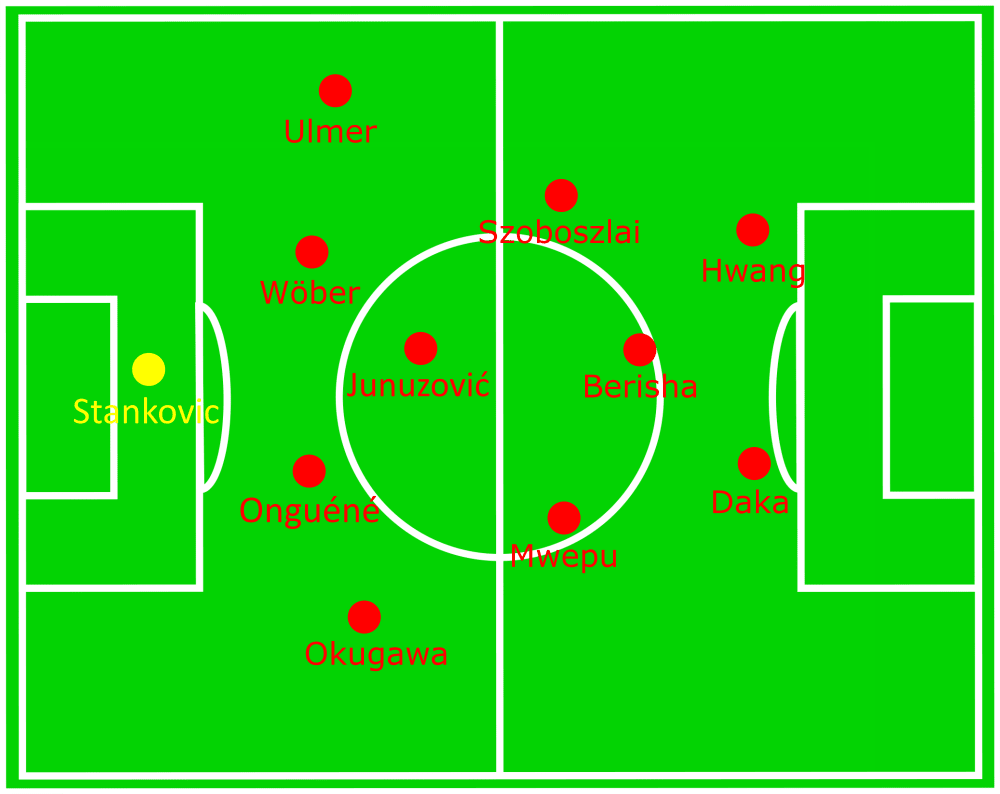
The first surprise was that Okugawa played as a right-back since he’s an offensive midfielder or winger. Additionally, Mergim Berisha, who returned in this winter from his loan at Altach, played as a number 10 behind the strikers and was the only man in Salzburg’s offence who is strong in the air and was then the target for Salzburg’s long balls.
Anyways, it was maybe not the best idea to put Okugawa in this position as you noticed that he isn’t used to it. His positioning was not perfect, what is logical, but the greater problem was that he tried in some situations to dribble forward even though he had two opponents against him, and that’s quite dangerous as a full-back as there are only the centre-backs to give you the protection. We can see an example below as he starts to dribble against two opponents and in the end, he needs to do the tactical foul to avoid a counter-attack.
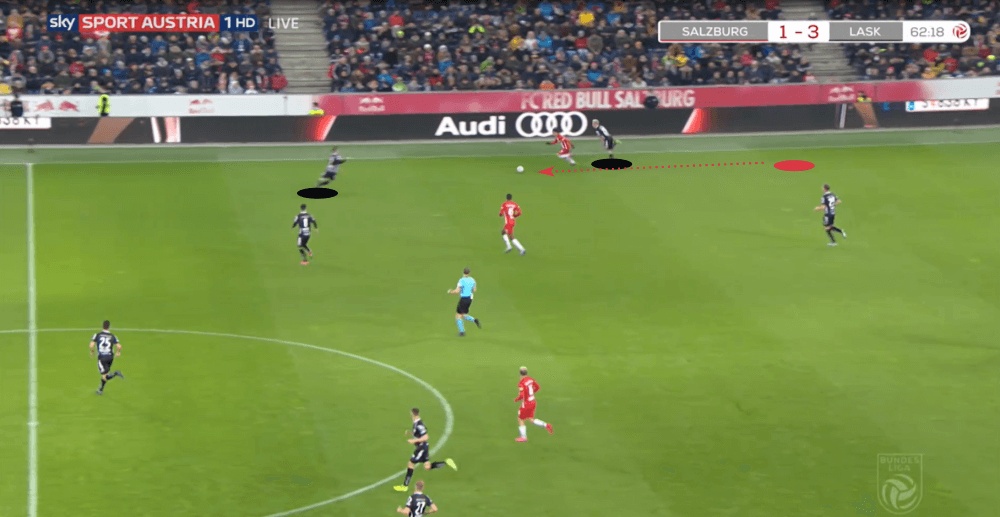
But there occurred another huger problem as this formation is once more one with quite a lot of bodies in the centre and just the full-backs occupy the wing. Due to that, you often had the feeling that the full-backs were extremely isolated as soon as they got on the ball, and it was easy for LASK to put pressure on them as we can see in the image below. Even though Ulmer was in this situation able to bring the ball into the central area, the way was for the ball so long, that the players of Linz were able to intercept it.
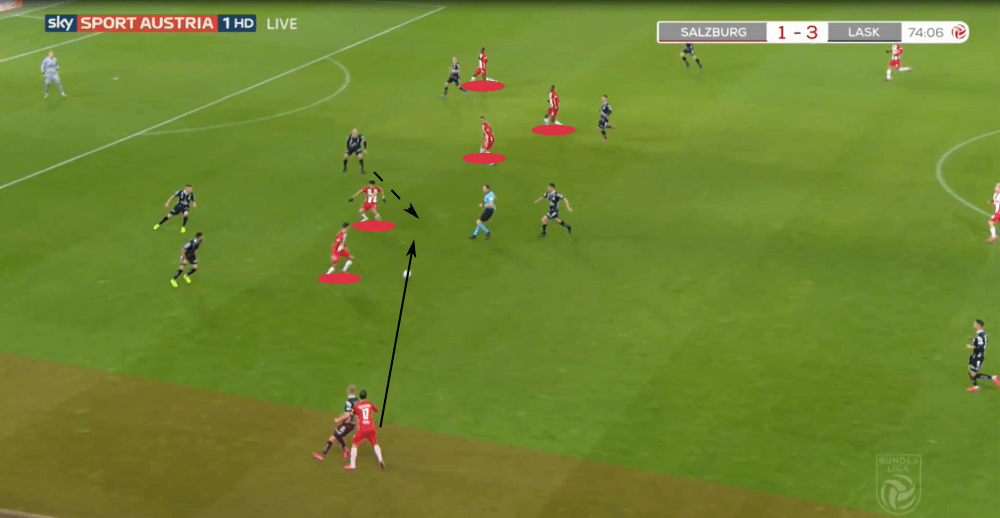
Set-pieces as a deciding factor
As the last topic of this tactical analysis of this clash between the two best teams Austria has to offer, we’ll look at the set-pieces since two out of the five goals in this match were a result of set-pieces. Anyways, we’ll only analyze the throw-in routine of LASK, which led to the opening goal of the day while we shortly analyze the corners of Salzburg as they scored the 2:3 after such one.
At first, we’ll look at the throw-in pattern of LASK Linz, which brought them in front even though until then, RB Salzburg had way more goalscoring chances in this game. As soon as the throw-in was high up the pitch, not the wing-backs made it, but the central midfielder Holland who can throw the ball into the penalty box, and he did so five times in this match. As we can see in the image below, in these situations, Trauner and Raguž who both are extremely strong in the air are near the first post, and they should win their aerial dues to bring the ball towards the second post or in front of the goal where then one of their teammates should score the goal.
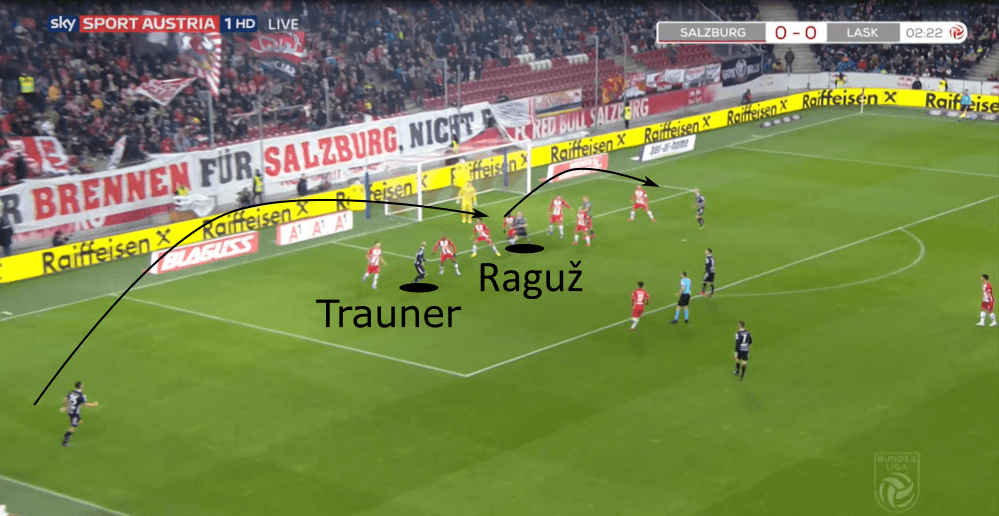
This pattern worked off perfectly in the 20th minute as Trauner won his aerial duel while the ball got deflected once more and then Frieser was completely left alone at the second post and just had to tap it in to score the opening goal of the day.
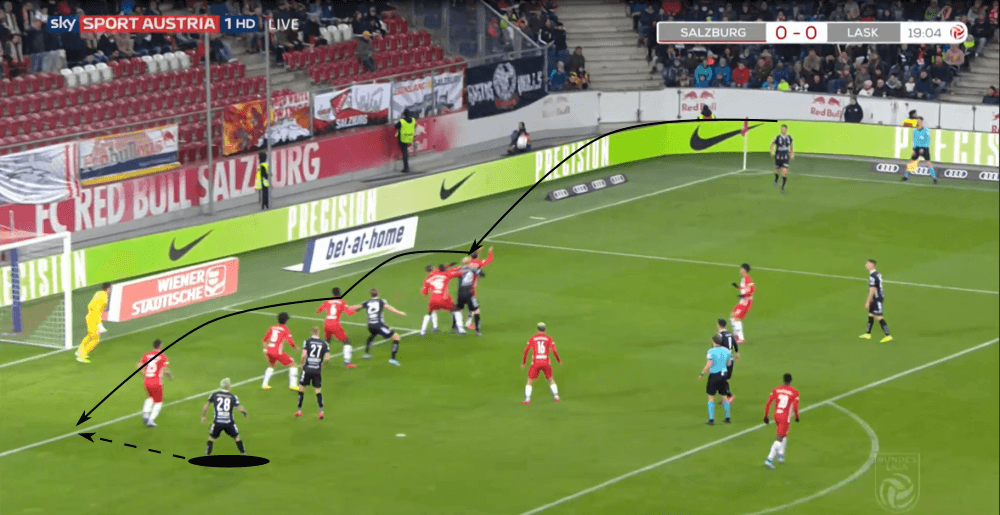
It was ahead of this match clear that it would be hard for Salzburg to score a goal after a corner since LASK Linz are among the best teams when it comes to defending during set-pieces especially since they have several players who are strong in the air.
Linz always have five players in one row ahead of the goal with the central forward (Raguž at the first post), the three centre-backs and Holland (at the second post) who is clearly the weakest one of these when it comes to aerial duels. Then, they have two players in front of them who should block the opponents. Salzburg’s biggest issue during their first corners was that almost every cross came towards the first post where LASK had the players who are extremely strong in the air and due to that, they easily cleared these situations as in the example below.
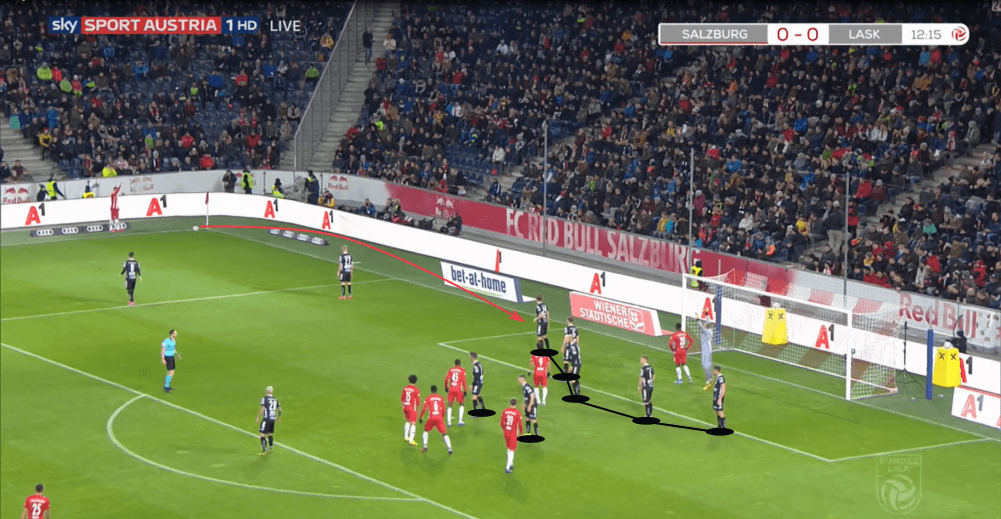
However, in the 81st minute, Mwepu scored with a header after a corner as this time the ball was towards the second post and besides perfectly placed, so it was hard for the defenders of Linz to get into the aerial duel. Because of that, Mwepu had enough space to place the ball with a header into the bottom left corner to score the 3:2, but his team weren’t able to score the equalizer in the remaining minutes.
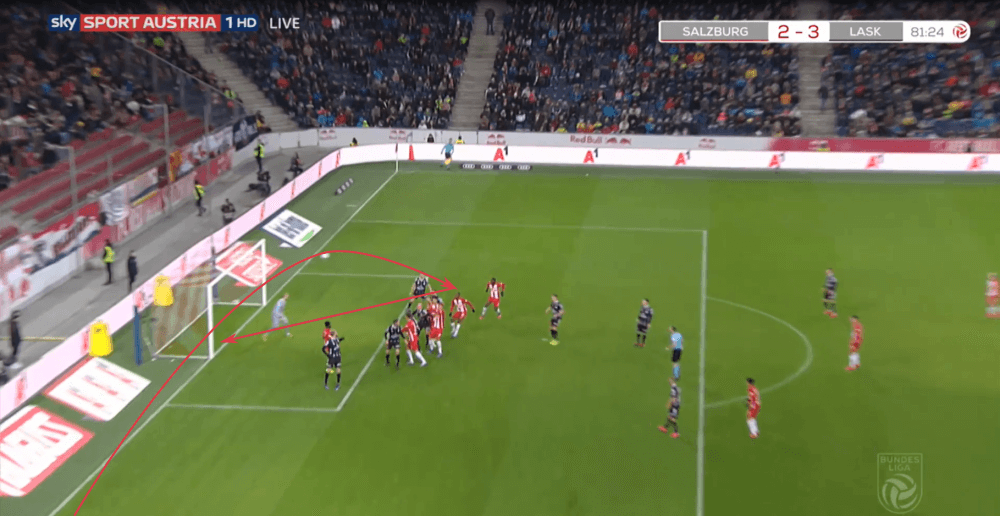
Conclusion
After the departure of the coach Oliver Glasner who joined in the summer the Bundesliga club Wolfsburg from LASK Linz, many people weren’t sure if Linz could keep up with RB Salzburg. However, after the 19th round, the team of Ismaël is one point ahead of Salzburg due to this victory.
This game was quite interesting as both teams used interesting tactics and the game was in general on quite a high level. It will be interesting to see how the fight for the championship will develop and besides, both teams are still in the UEFA Europa League. After this game, you can especially expect from LASK that they perform also well in this international competition.





Comments